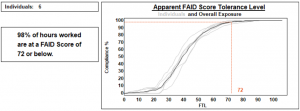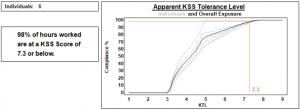Issue #67 – January 2021
Welcome to Focus on Fatigue for 2021! We hope you have had a restful holiday period.
We thought we would kick of this year’s Focus on Fatigue by addressing a common question that we receive; “What is an appropriate fatigue tolerance level?” Unfortunately, it is not one that can be answered in a simple sentence. There are a number of factors that need to be considered when setting fatigue tolerance levels, which we will explore in this month’s feature article.
The FRMS Team
![]()
InterDynamics Pty Ltd
320 Adelaide Street Brisbane Qld 4000
Tel +61 7 3229 8300
www.interdynamics.com
Views expressed in articles and links provided are those of the individual authors, and do not necessarily represent the views of InterDynamics (except where directly attributed).
What is an appropriate fatigue tolerance level?
Fatigue is inevitable
There are many situations where fatigue is unavoidable; particularly when working across a 24 hour roster, which works against our natural circadian rhythm. This is why we talk about managing fatigue rather than eliminating fatigue. Managing fatigue requires a risk based approach involving a combination of interventions, including managing fatigue exposure, identifying risk, appropriate controls and appropriate fatigue training.
Fatigue tolerance levels
As users of FAID Quantum would be aware, FAID Quantum uses fatigue tolerance levels to assist in its reporting of hours of work related fatigue exposure. FAID Quantum allows the user to set a FAID Score and KSS tolerance level (or multiple tolerance levels). Desired compliance percentages can also be set. FAID Quantum provides reports specific to these settings. So, what is an appropriate fatigue tolerance level?
Task risk and other considerations
When using FAID Quantum, there is no standard fatigue tolerance level recommended. This is because there are a number of considerations when setting a tolerance level.
Not all tasks carry the same risks
Some tasks or roles are more sensitive to fatigue related impairment and/or have significant consequence in the event of a fatigue related error. For example, if someone working an admin role had a micro sleep at their desk, the potential consequences differ to that of a pilot having a micro sleep during final approach. Therefore, the level of fatigue exposure deemed acceptable in different roles may differ.
Controls/protections may be in place
Controls/protections may be in place to reduce the risks associated with fatigue for a particular task/role, impacting the fatigue exposure tolerated.
Fatigue scores are based on the average situation
Hours of work fatigue scores (KSS & FAID Score) are based on average exposure and opportunity for recovery sleep. Some environments may provide the opportunity for more (or less) rest and recovery sleep, influencing the tolerance level that is deemed appropriate. For example, workers living on site, with meals provided and other domestic tasks taken care of, have less commute time and less external time pressures than the average situation.
Workplace culture has a significant impact on the way fatigue issues will be handled by employees within an organisation. Organisational culture is often defined as “the way we do things around here” and is formed by a combination of beliefs, values and assumptions; all of which influence how people interact and behave.
Fatigue Hazard Analysis
To determine an appropriate tolerance level, we recommend an organisation carry out a Fatigue Hazard Analysis (FHA) risk assessment specific to their workplace and tasks. That is, a risk assessment which reviews the hazards of a role when fatigue is present.
Current hours of work fatigue exposure
The FHA risk assessment would consider, amongst other things, the current hours of work fatigue exposure which can be analysed using FAID Quantum. The apparent fatigue tolerance level reports (for KSS & FAID Score) provide an indication of the current hours of work fatigue exposure, most appropriately reflected when at least 6 to 12 months of the most recent actual hours of work data is analysed. It is often helpful for an organisation to take into consideration its current apparent tolerance level in setting a fatigue tolerance level. Until an organisation conducts a FHA, one option is to use the Apparent FAID Score Tolerance Level (FTL) & Apparent KSS Tolerance Level (KTL) as a rough guide. However, it is important to note, the apparent tolerance level does not necessarily represent a safe work environment.

The above apparent fatigue tolerance level reports from FAID Quantum show the current hours of work fatigue exposure of an organisation being at an Apparent FTL of 72 and Apparent KTL of 7.3.
Analysis of fatigue related data
For organisations that have collected fatigue related performance data, FAID Quantum provides the ability to investigate relationships between fatigue exposure (KSS & FAID Score) and the performance data, using the external results function. This may relate to safety incidents, but can also relate to other factors such as absenteeism, complaints or driver efficiency. You can read more here.
This data can provide insight to identify potential correlation between fatigue exposure and incidents. Such analyses can be helpful in determining appropriate fatigue tolerance levels for a particular environment.
Further reading
For further information about setting fatigue tolerance levels and what KSS & FAID Scores represent, you can read Establishing a Fatigue Tolerance Level.
In the News
Provided below are a selection of articles from around the web on the issues associated with fatigue. We hope you find them useful and interesting.
Video: What would happen if you stopped sleeping, day by day
Abby Tang & Andrea Schmitz, Science Insider, November 2020
“Why do we sleep?” has been a notoriously difficult question for scientists to answer, but, “What happens if we don’t?” is actually pretty simple — nothing good. Not getting enough sleep can make you hallucinate, mess with your thinking and memory, and even lead to organ failure. And it doesn’t take very long at all for these negative effects to start occurring. Here’s what would happen to your brain and body, day by day, if you stopped sleeping.
Article: Want your employees to be more productive? Make sure they catch those zzzs.
João Mendes-Roter, Entrepreneur, January 2021
According to the Centers for Disease Control and Prevention, more than one in three American adults fail to get enough sleep on a regular basis — jeopardizing their overall health while making them less productive, more error-prone and at higher risk of injury in the workplace. The annual cost to employers? Research indicates that it’s hundreds of billions of dollars.
Article: Sleep evolved before brains did, study finds
Rachael Rettner, Live Science, January 2021
Our brains need sleep to work properly. But it turns out you don’t need a brain to sleep. In a new study, researchers identified a sleep-like state in a tiny, freshwater animal called a hydra, which has a simple anatomy and lacks a brain.

